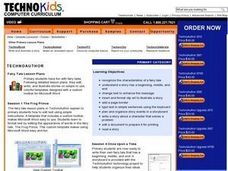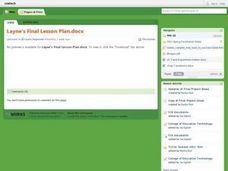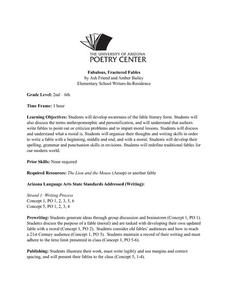Curated OER
Writing: Mentor Text Lesson & Microteaching
Mentor texts are a great way to demonstrate how to write with purpose. Pupils will be reintroduced to two well-known books and then asked to think about them from the writer's point of view. They will see that the author had to use basic...
Curated OER
Techno Author
Here is a great way to explore language arts by completing a computer activity with classmates. Youngsters read a fairy tale in class and analyze where the beginning, middle and end are. They create their own story using clip art and...
Curated OER
Where Do We Begin?
Primary learners grasp sequence of events by discussing morning routines and reviewing the story of Little Red Riding Hood. They explore the necessity of correct order of events. As a class, create a story with a beginning, middle, and...
Curated OER
Crater Creation
After looking at the back of a quarter featuring Oregon terrain, learners distinguish between fiction and non-fiction and identify the beginning, middle and end of a story. First, they listen to legends that describe the creation of...
Curated OER
Build Mastery: Sequencing
Writing a summary is much easier once you've laid out the sequence of events. Show readers how these two skills are intertwined using this graphic organizer. Review the meaning of sequencing first, presenting the chart and possibly...
Curated OER
Fairy Tales
Once upon a time are four words most children are familiar with when reading a fairy tale. But do they know that fairy tales are a great way to learn the literary elements of reading and writing? Use a thorough fairy tale unit...
Curated OER
Story Stick Medallions
Students identify and visually represent important events in the beginning, middle, and end of a story. They arrange the pictures in sequential order. Students verbalize details while they retell their story idea to friends and family...
Curated OER
Sequencing in Reading
Third graders explore language arts by analyzing a children's story in class. In this story structure instructional activity, 3rd graders read the book The True Story of the Three Little Pigs and write a brief summary. Students identify...
For the Teachers
Sequence Plot Chart
Your kids can identify the plot sequence of a short story, but what about an informational article? Have them examine the chronological order of events in informational texts with a activity on the sequence of events.
Curated OER
Using Children's Literature to Teach Writing: No, David!
Students review beginning, middle, and end of a story and how details add to a story.
Curated OER
Monitoring Comprehension Progress: Story Retells
Pupils retell a story by filling out a record sheet. In this retelling lesson plan, students fill out a record sheet that gives them prompts about the beginning, middle, and end of a story.
Curated OER
Animation Pre-Production
Does your class love reading cartoons? Use their talents and interests to examine the process of writing a story they wish to tell through a cartoon. They develop the beginning, middle, and end of a story based on their original...
Poetry4kids
How to Write a Cinquain Poem
A lesson challenges scholars to create a cinquain poem. Writers begin by choosing a topic and brainstorm details, then compose their original poem making sure to count syllables.
Curated OER
Telling a Story
Young scholars create a story about a picture. For this writing lesson, students select a picture and write a story about what happened in the picture. Young scholars are encouraged to write a story with a beginning, middle, and end.
Curated OER
Writing Lesson Plan: Stop and Go: Capitals and Periods
Examine writing using a fun, interactive format. Young writers choose a piece of their own writing to proofread for initial capitals and final periods they left out. They work independently using green stickers to add capitals and red...
Curated OER
Fabulous, Fractured Fables
Elementary schoolers develop an awareness of the literary form known as the fable. They explore how authors write fables to pass along moral lessons. After reading and discussing many famous fables embedded in the plan, learners attempt...
Scholastic
Transitional Guided Reading
Use a fill-in-the-blank lesson plan template to enhance your guided reading lesson plans with details surrounding decoding strategies, fluency and phrasing, vocabulary strategies, comprehension, and more!
Curated OER
Writer's Workshop Mini-Lesson Plan- Story Sequencing
Students listen to a read aloud of Kevin Henkes, Owen, while listening for the beginning, middle, and end. They listen as the teacher describes the need for story organization and write down the story sequence. Finally, they create a...
Curated OER
Narrative Literature Response Letters: Original Lesson Plan
Readers write a formal letter to an author offering an alternative ending to a story the author has written. First, the class reads a story or novel. Upon finishing the reading, they are introduced to the format of a formal letter. They...
Hawaiʻi State Department of Education
Story Design
Stories contain very specific elements; plot, characters, and key events. Learners use pantomime to retell a key event from the beginning, middle, and end of a story. They discuss setting and character as each group discusses and then...
Curriculum Corner
Summary Writing
Nineteen stylish worksheets offer lesson ideas and practice opportunities designed to reinforce summary skills. Scholars recall events over the weekend as well as favorite books—main characters, problems, solutions, the beginning,...
Curated OER
Introduce: Summarizing Narrative Text
When scholars re-tell a story, do they boil it down to important details in a logical order? Practice summarizing narratives using this think-aloud strategy, which is scripted here for your convenience. After explaining why this is an...
Curated OER
Metallic Galactic Mobile
Students create 3-dimensional models of their own imaginary galaxies of newly discovered planets. They write fictional accounts of their experiences visiting each new planet. Students writing includes a recognizable beginning, middle,...
Curated OER
Tell A Visual Story
Pupils become aware of a story's sequence by identifying a story's beginning, middle/climax and end. They utilize their auditory and visual/kinesthetic abilities to interpret, organize, and represent a story's sequence in original pictures.























